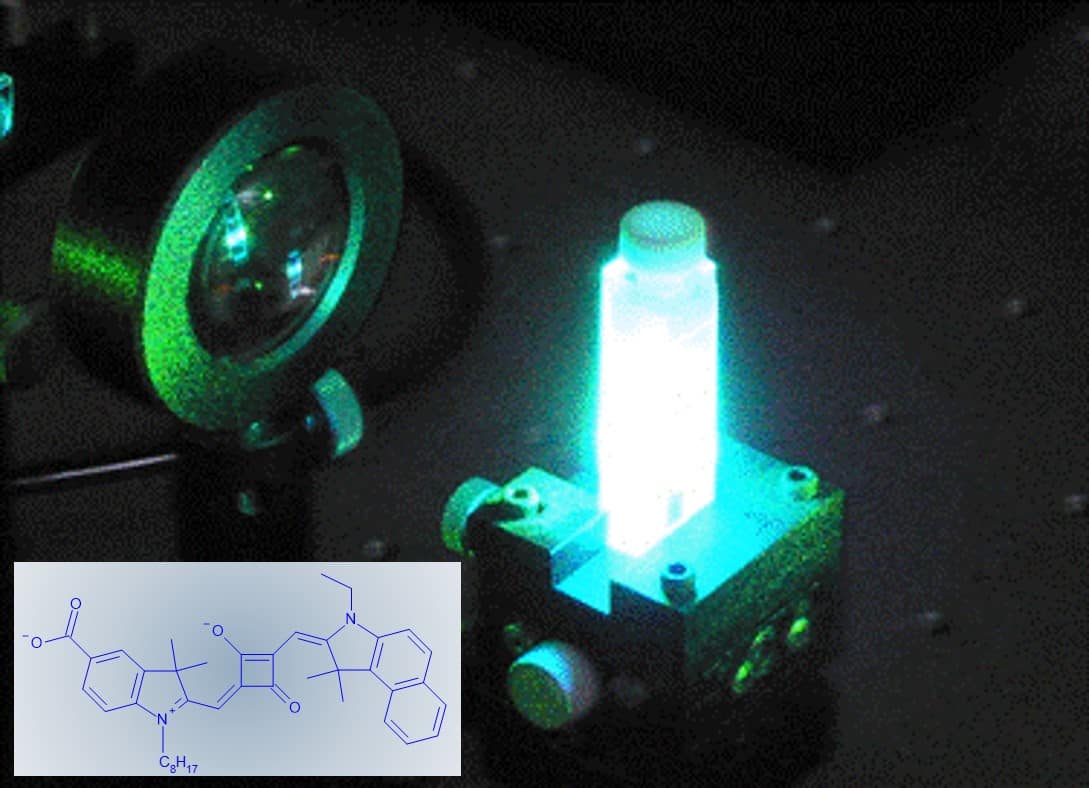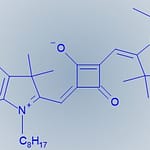やさしく解説:SQ2 × 過渡吸収(Transient Absorption)— 赤外に強い色素の“速い挙動”をのぞく【日本語版】
更新日:2025-11-01 / 対象:一般向け解説
まずは60秒で
- SQ2 は スクアライン(squaraine)系色素。深い赤〜近赤外の光を強く吸収し、**DSSC(色素増感太陽電池)**の“赤外担当”として頼りになります。
- 過渡吸収(TA)分光は、フェムト秒〜ナノ秒の時間スケールで、電子注入・励起子移動・再結合など“高速イベント”を直接観測します。
- 研究報告では、アンカー基(カルボン酸 vs. ホスホン酸)やπブリッジの違いで、注入効率や再結合速度が変わることが TA から明確に示されています(例:SQ2派生で8.9% PCE、TAでホスホン酸は注入低下を示唆) :contentReference[oaicite:0]{index=0}。
1. TA分光ってなに?(やさしく)
- やっていること:超短パルスで“たたく”(ポンプ)→ もう一方で“観る”(プローブ)。
- 見えるもの:
- **励起子(光でできた束)**の寿命・動き
- 電子注入(色素→TiO₂)の立ち上がり
- 電荷再結合の減衰
- 凝集(H/J会合)や励起子結合のサイン(バンドのシフトや双極子向き依存)
一言でいえば、TA = “発電プロセスの心拍計”。セルの良し悪しを時間軸で見抜けます。
2. SQ2で注目の“速い現象”
- 電子注入の速さ:カルボン酸(–CO₂H)アンカーの SQ2 誘導体は、TiO₂ への注入が速く、結果として Jsc/Voc が伸びやすい傾向。**ホスホン酸(–PO₃H₂)**では 注入が鈍る例が TA で観測(→ Jsc低下に対応) :contentReference[oaicite:1]{index=1}。
- 励起子結合と移動:SQ2ダイマー等では、結合の強さにより、局在↔非局在や一時的なデローカライズ→効率的移動など複数の挙動が現れることが TA で整理されています(“強結合”では非局在、“中間”では一時的局在化、“弱結合”ではフォスター型移動が優勢) :contentReference[oaicite:2]{index=2}。
- ヘテロ複合化での発光向上:BODIPY×SQ2の“連結体”では、励起子結合が生じ、低エネルギーバンドの遷移モーメントが増強→量子収率アップ。偏光依存TAや蛍光アップコンバージョンで実証 :contentReference[oaicite:3]{index=3}。
3. DSSC設計でTAが教えてくれること
- (A)アンカー基の最適化:–CO₂H優勢のケースでは 注入立ち上がりが速く、–PO₃H₂は遅い→界面設計の指針に。
- (B)πブリッジ・置換基:π拡張で吸収/ICT強化、ただし凝集が出やすい。TAのバンド形状・成分解析で凝集/結合の程度を診断。
- (C)凝集制御:CDCA等の共吸着剤でH/J会合を抑え、注入・再結合バランスを改善。
- (D)共増感戦略:SQ2=赤外担当、青〜緑担当の色素と同時/段階吸着→Jsc底上げ。TAで**相互干渉(エネルギー移動・消光)**の有無をチェック。
4. 実験Tips(最初のスクリーニング)
- 過密吸着を避ける:まずは やや薄付きから。吸着時間と濃度を振る。
- CDCA 1–3 mM:凝集サイン(スパイク状 ESA、青シフト等)が薄れるか TAで確認。
- 電解質:I⁻/I₃⁻ vs コバルト錯体で Voc/再結合の最適点を探る(**TBP, Li⁺**添加も少量から)。
- 共増感:スペクトル補完関係のペアを選び、同時/段階の二法を比較。TAで寄与分の分離(グローバル解析)を試す。
5. よくある質問
Q1. なぜSQ2は近赤外までよく吸うの?
→ スクアリン核+拡張共役によりICT遷移が低エネルギー側で強く起こるため。
Q2. TAで“良いセル”はどう見える?
→ 注入の立ち上がりが速い、再結合の成分が弱い/遅い、凝集サインが小さい。
Q3. まず何から?
→ (i)–CO₂Hアンカー×CDCAで凝集抑制、(ii)過剰吸着回避、(iii)青緑担当色素との共増感。
参考(読みやすい要点)
- SQ2派生DSSC:8.9%(DTS-πブリッジ×–CO₂H)、TAで–PO₃H₂は注入低下を示唆(Chem. Mater., 2015)。
- SQ2ダイマー列の励起子動力学:強結合〜弱結合で挙動が変化(J. Phys. Chem. C, 2018)。
- BODIPY–SQ2複合の励起子結合:偏光依存TAとFUで発光強化(J. Am. Chem. Soc., 2015)。
(出典まとめ::contentReference[oaicite:4]{index=4})
Gentle Guide: SQ2 × Transient Absorption — Seeing Ultrafast Steps in Deep-Red Dyes【English Version】
Updated: 2025-11-01 / For general readers
60-second summary
- SQ2 (a squaraine dye) strongly absorbs deep-red to NIR light and serves as a red extender in DSSCs.
- Transient absorption (TA) resolves fs–ns events: electron injection, exciton motion, recombination.
- Reports show that anchoring groups (–CO₂H vs –PO₃H₂) and π-bridges reshape injection and recombination; a DTS-bridged squaraine with –CO₂H reached 8.9% PCE, while TA indicated slower injection for –PO₃H₂ analogs. :contentReference[oaicite:5]{index=5}
1) TA in plain words
Pump with an ultrafast pulse, probe the instantaneous spectrum. You directly see injection rise, exciton transfer, and recombination decay—a heartbeat monitor for the cell.
2) What TA reveals for SQ2
- Injection kinetics: –CO₂H anchoring → faster injection into TiO₂; –PO₃H₂ → reduced injection (lower Jsc), consistent with TA signatures. :contentReference[oaicite:6]{index=6}
- Excitonic coupling: In SQ2 dimers, TA distinguishes strong / intermediate / weak coupling regimes: delocalized, transiently (de)localized, and Förster-type transfer, respectively. :contentReference[oaicite:7]{index=7}
- Hetero-conjugates: BODIPY–SQ2 assemblies show intensity borrowing; polarization-dependent TA and fluorescence upconversion explain red-shifted bands and higher quantum yields. :contentReference[oaicite:8]{index=8}
3) Design levers informed by TA
- Anchors: Prefer –CO₂H when injection is limiting; verify with TA rise.
- π-bridges & substituents: Extend conjugation but watch aggregation; TA band shapes help diagnose H/J signatures.
- Co-adsorbent (CDCA): Suppress packing, stabilize spectra and charge transfer.
- Co-sensitization: Pair red-NIR SQ2 with blue/green absorbers; use TA to check energy-transfer or quenching.
4) Quick lab checklist
- Avoid over-dense loading first; titrate adsorption time.
- Test CDCA 1–3 mM; check TA for reduced H/J features.
- Compare I⁻/I₃⁻ vs Co-complex electrolytes; fine-tune with TBP, Li⁺.
- Try simultaneous vs stepwise co-sensitization; use global analysis of TA.
5) FAQ
Why does SQ2 reach NIR?
Strong ICT transitions from the squaraine core + extended π-system.
What does a “good” cell look like in TA?
Fast injection, weaker/slower recombination, minimal aggregation signatures.
Where to start?
(i) –CO₂H + CDCA, (ii) avoid overloading, (iii) add blue/green partner dye.
Sources (digest)
- Chem. Mater. (2015): π-bridges/anchors; 8.9% PCE with –CO₂H; TA shows slower injection for –PO₃H₂.
- J. Phys. Chem. C (2018): SQ2 dimers; strong→weak coupling regimes in TA.
- J. Am. Chem. Soc. (2015): BODIPY–SQ2 superchromophores; polarization-dependent TA & FU.
:contentReference[oaicite:9]{index=9}


